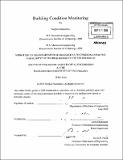Building condition monitoring
Author(s)
Samouhos, Stephen V. (Stephen Vincent), 1982-
DownloadFull printable version (25.42Mb)
Other Contributors
Massachusetts Institute of Technology. Dept. of Mechanical Engineering.
Advisor
Leon Glicksman.
Terms of use
Metadata
Show full item recordAbstract
The building sector of the United States currently consumes over 40% of the United States primary energy supply. Estimates suggest that between 5 and 30% of any building's annual energy consumption is unknowingly wasted due to pathologically malfunctioning lighting and comfort conditioning systems. This thesis is focused on developing analytical methods embodied within useful software tools to quickly identify and evaluate those building system faults that cause large building energy inefficiencies. The technical contributions of this work include expert rules that adapt to HVAC equipment scale and operation, a general framework for applying probabilistic inference to HVAC fault detection and evaluation, and methods for sorting fault signals according to userdefined interests such as annual cost of energy inefficiencies. These contributions are particularly unique in their treatment of model and measurement uncertainty within the fault inference, and the careful consideration of user interests in fault evaluation. As a first step to developing this general framework for fault detection, I targeted first order faults such as simultaneous heating and cooling and imbalanced air flows within several large air-handling units in three buildings on the MIT campus. Experiments included the purposeful implementation of mechanical and software control programming faults on otherwise fault-free equipment. Between the five pieces of equipment, the software system successfully identified all previously known and experimentally implemented faults, as well as additional faults that had not been previously identified or imposed during the experiment. User testing and experiments show that embracing uncertainty within HVAC fault detection and evaluation is not only paramount to judicious fault inference but it is also central to gaining the trust and buy-in of system users who ultimately can apply fault detection information to actually fix and improve building operations.
Description
Thesis (Ph. D.)--Massachusetts Institute of Technology, Dept. of Mechanical Engineering, 2010. Cataloged from PDF version of thesis. Includes bibliographical references (p. 201-206).
Date issued
2010Department
Massachusetts Institute of Technology. Department of Mechanical EngineeringPublisher
Massachusetts Institute of Technology
Keywords
Mechanical Engineering.